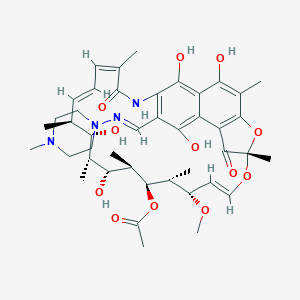| 1 |
Recurrent recessive mutation in deoxyguanosine kinase causes idiopathic noncirrhotic portal hypertension.Hepatology. 2016 Jun;63(6):1977-86. doi: 10.1002/hep.28499. Epub 2016 Mar 31.
|
| 2 |
Drugs used to treat Parkinson's disease, present status and future directions. CNS Neurol Disord Drug Targets. 2008 Oct;7(4):321-42.
|
| 3 |
Spironolactone FDA Label
|
| 4 |
URL: http://www.guidetopharmacology.org Nucleic Acids Res. 2015 Oct 12. pii: gkv1037. The IUPHAR/BPS Guide to PHARMACOLOGY in 2016: towards curated quantitative interactions between 1300 protein targets and 6000 ligands. (Ligand id: 2875).
|
| 5 |
Spironolactone in Covid-19 Induced ARDS
|
| 6 |
Bacillus subtilis tolerance of moderate concentrations of rifampin involves the sigma(B)-dependent general and multiple stress response. J Bacteriol. 2002 Jan;184(2):459-67.
|
| 7 |
Expression and distribution of CYP3A genes, CYP2B22, and MDR1, MRP1, MRP2, LRP efflux transporters in brain of control and rifampicin-treated pigs. Mol Cell Biochem. 2010 Apr;337(1-2):133-43.
|
| 8 |
Mammalian drug efflux transporters of the ATP binding cassette (ABC) family in multidrug resistance: A review of the past decade. Cancer Lett. 2016 Jan 1;370(1):153-64.
|
| 9 |
Arginine-482 is not essential for transport of antibiotics, primary bile acids and unconjugated sterols by the human breast cancer resistance protein (ABCG2). Biochem J. 2005 Jan 15;385(Pt 2):419-26.
|
| 10 |
Human organic anion transporting polypeptide-C (SLC21A6) is a major determinant of rifampin-mediated pregnane X receptor activation. J Pharmacol Exp Ther. 2003 Jan;304(1):223-8.
|
| 11 |
Interactions of rifamycin SV and rifampicin with organic anion uptake systems of human liver. Hepatology. 2002 Jul;36(1):164-72.
|
| 12 |
Drugs@FDA. U.S. Food and Drug Administration. U.S. Department of Health & Human Services.
|
| 13 |
Receptor-dependent regulation of the CYP3A4 gene. Toxicology. 2002 Dec 27;181-182:199-202.
|
| 14 |
Examination of 209 drugs for inhibition of cytochrome P450 2C8. J Clin Pharmacol. 2005 Jan;45(1):68-78.
|
| 15 |
Early identification of clinically relevant drug interactions with the human bile salt export pump (BSEP/ABCB11). Toxicol Sci. 2013 Dec;136(2):328-43.
|
| 16 |
A Gene Expression Biomarker Identifies Chemical Modulators of Estrogen Receptor in an MCF-7 Microarray Compendium. Chem Res Toxicol. 2021 Feb 15;34(2):313-329. doi: 10.1021/acs.chemrestox.0c00243. Epub 2021 Jan 6.
|
| 17 |
Effect of spironolactone on impaired fibrinolysis of hypertensive patients. Kidney Blood Press Res. 2002;25(4):260-4. doi: 10.1159/000066348.
|
| 18 |
Amiloride, spironolactone, and potassium chloride in thiazide-treated hypertensive patients. Clin Pharmacol Ther. 1980 Apr;27(4):533-43. doi: 10.1038/clpt.1980.75.
|
| 19 |
Effect of spironolactone on plasma brain natriuretic peptide and left ventricular remodeling in patients with congestive heart failure. J Am Coll Cardiol. 2001 Apr;37(5):1228-33. doi: 10.1016/s0735-1097(01)01116-0.
|
| 20 |
Spironolactone induces apoptosis in human mononuclear cells. Association between apoptosis and cytokine suppression. Apoptosis. 2006 Apr;11(4):573-9. doi: 10.1007/s10495-006-4919-3.
|
| 21 |
Evaluation of an imaging-based in vitro screening platform for estrogenic activity with OECD reference chemicals. Toxicol In Vitro. 2022 Jun;81:105348. doi: 10.1016/j.tiv.2022.105348. Epub 2022 Mar 18.
|
| 22 |
Pregnane X receptor mediates the induction of P-glycoprotein by spironolactone in HepG2 cells. Toxicology. 2011 Jul 11;285(1-2):18-24. doi: 10.1016/j.tox.2011.03.015. Epub 2011 Apr 1.
|
| 23 |
The human mineralocorticoid receptor only partially differentiates between different ligands after expression in fission yeast. FEMS Yeast Res. 2005 Apr;5(6-7):627-33. doi: 10.1016/j.femsyr.2004.12.007.
|
| 24 |
Comparison of the Hershberger assay and androgen receptor binding assay of twelve chemicals. Toxicology. 2004 Feb 15;195(2-3):177-86. doi: 10.1016/j.tox.2003.09.012.
|
| 25 |
Palmitate increases the susceptibility of cells to drug-induced toxicity: an in vitro method to identify drugs with potential contraindications in patients with metabolic disease. Toxicol Sci. 2012 Oct;129(2):346-62. doi: 10.1093/toxsci/kfs208. Epub 2012 Jun 14.
|
| 26 |
Clinical and biochemical effects of spironolactone administered once daily in primary hypertension. Multicenter Sweden study. Hypertension. 1980 Sep-Oct;2(5):672-9. doi: 10.1161/01.hyp.2.5.672.
|
| 27 |
Human paraoxonases (PON1, PON2, and PON3) are lactonases with overlapping and distinct substrate specificities. J Lipid Res. 2005 Jun;46(6):1239-47. doi: 10.1194/jlr.M400511-JLR200. Epub 2005 Mar 16.
|
|
|
|
|
|
|


